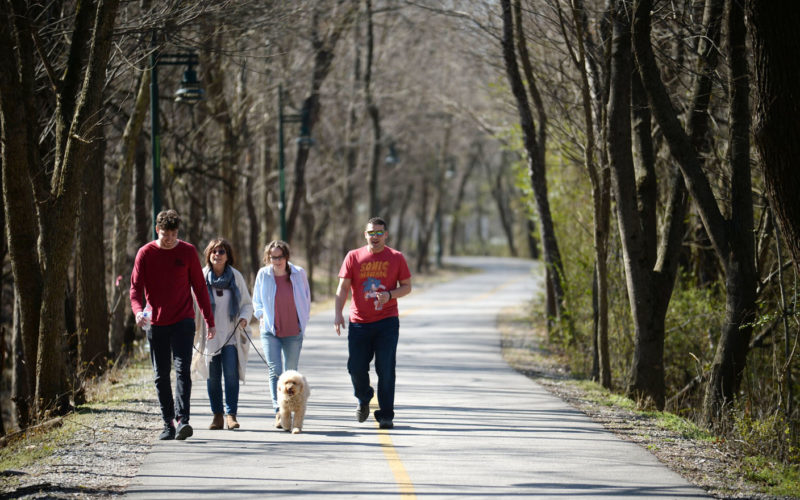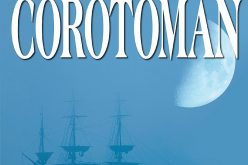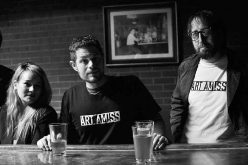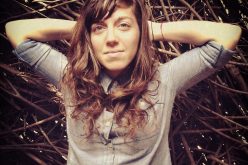Bond project to blend nature, art, officials say
STACY RYBURN
sryburn@nwadg.com

The Free Weekly/ANDY SHUPE
Construction work continues along the trail west of the Fayetteville Public Library. Voters will be asked April 9 to continue the city’s 1 percent sales tax to pay for about $226 million in projects. Of that, about $30 million would go toward building an arts corridor and parking downtown. Part of the arts corridor plan includes turning the Fay Jones Parkland woods into a natural attraction with a canopy walk, trail connections and restored vegetation and streamside areas.
Fayetteville city officials envision a time when people will go downtown just for the sake of it, regardless of how much money is in their pockets.
A project included in the city’s proposed bond referendum would make that happen, administrators say.
Voters will head to the polls April 9 to decide whether they want to continue the city’s 1 percent sales tax to generate about $226 million toward various projects. Nearly $32 million is included to build what city officials are calling a cultural arts corridor.
The arts corridor includes a three-acre civic gathering space at Dickson Street and West Avenue, where the Walton Arts Center parking lot is now. It also involves turning the seven-acre or so Fay Jones Parkland woods immediately west of the Fayetteville Public Library into a nature attraction. Also included are improvements to West Avenue and the Razorback Greenway.
The bond measure has a provision to build a parking deck replacing the 290 spaces that would be lost at the Walton Arts Center lot. Mayor Lioneld Jordan has said no work will start on the civic space until the replacement parking is finished. Language in the ballot measure ensures that.
City administrators see the corridor as a potential economic draw, a free venue for visitors to experience art and events, an environmental-protection measure and stimulus to the downtown scene.
“I just want the people to see it,” Jordan said. “I know a lot of folks say, ‘Well, that could be just kind of pie in the sky.’ I say you know, it could be. But that pie gets divided up into several pieces, and I want everybody to have a little piece of the pie.”
Energy, life
About $11 million is budgeted to build the civic space. It would take up the entire lot at West Avenue from Dickson to Spring streets. City officials are billing it as a multipurpose, open gathering space with vendors, performances, art and environmental features.
The arts corridor, and particularly the civic space, would serve as a much-needed investment in downtown, said Peter Nierengarten, the city’s director of sustainability and parking. Downtowns in other Northwest Arkansas cities have seen an uptick in activity, while Dickson Street has largely remained the same, he said.
“I think some of the energy and life Dickson had a monopoly on for a lot of years we now have to share with other communities,” Nierengarten said. “But in order to be competitive with those other communities, to me, the arts corridor represents something new and exciting and different.”
Conceptual designs show a canal pumping water from Tanglewood Branch and a walkway that would criss-cross the space. A large, grassy area for events with a stage would sit as the centerpiece. Gardens, seating areas and art installations would be sprinkled throughout.
Buildings could sit at the north and south ends. The plan suggests what kind of buildings they could be. One close to Dickson Street could possibly serve as a cafe, gallery and/or bicycle hub with restrooms. A building next to Spring Street could have offices, maker spaces for entrepreneurs, art galleries, a cafe or restaurant.
Neither building is included in the budget for the arts corridor. Those would come about through a partnership with a business owner or developer, city officials have said.
Molly Rawn, director of the city’s tourism bureau, Experience Fayetteville, said the designs for the civic space are merely the beginning. The programming that will roll out as the corridor is built will define what the area means to residents, she said.
The space would be used on days with no scheduled events, Rawn said. The everyday, social aspects, such as people having a place to sit and have lunch with a friend, are very much part of the purpose of the space, she said.
Parking, parking, parking
Public comments in surveys the city did about the arts corridor have a common theme: parking. Some commenters simply entered “parking” on every question. Others talked about how bad they view the parking situation now and how the arts corridor could make it worse.
The bond measure includes $10 million just for parking.
A study from Garver Engineering released earlier this month identified three potential sites for a parking deck. One is the lot across from the Spring Street parking deck on North School Avenue. Another is the train depot lot across Dickson north of the Walton Arts Center lot. The third is the site of Nadine Baum Studios.
The City Council won’t decide on a location until the bond measure passes, if it does. Jordan has said the option across from the Spring Street deck might be easiest because the city already owns that parking lot. The city would have to negotiate with landowners to build on the train depot lot. Jordan has said he’s not fond of the Nadine Baum option because it would involve tearing down the building.
No matter the location, the result would be more parking spaces than are available now, according to the study. The Nadine Baum option would create 26 more spaces. The train depot spot could have 33 or 39 additional spaces, depending on the design layout. The site across from the Spring Street deck could create 40 more parking spaces than what’s available now.
Joe Fennel, owner of Bordino’s and president of the Dickson Street Merchants Association, said the city’s commitment to replacement parking sealed his support for the arts corridor. Several business owners voiced concern about parking when the City Council decided in late December to send the bond referendum to voters.
The city heard those concerns, Fennel said. The language in the bond measure that explicitly states no work would start on the civic space until replacement parking is complete got the Merchants Association on board, he said.
The arts corridor also has gained the support of the Walton Arts Center Council. Peter Lane, arts center president and CEO, said the council supports all three options identified in the parking study. The biggest concern was preserving close parking for patrons, he said.
“Obviously, we are most supportive of the first two options,” Lane said. “The option to build parking at the location of Nadine Baum would require replacement of our existing theater and art studios and coordination with the city due to the existing long-term lease agreement we have on Nadine Baum Studios.”
Environmental, other aspects
Paved parking lots are prime offenders when it comes to polluting stormwater, say advocacy groups such as the Beaver Watershed Alliance. The arts corridor plan incorporates several measures to reduce the impact on the region’s drinking water supply.
The civic space would be designed to collect and purify stormwater. Water storage basins would be built under the surface with permeable pavers and bioswales lining the corridor.
West Avenue would get an overhaul with nearly $4 million budgeted. The street now has a 40-foot right of way, including sidewalks on both sides. The plan proposes expanding the right of way 8 feet. That would leave room for sidewalks and tree wells on both sides, with bioswales to capture stormwater, and bridged sidewalks in some parts over the stormwater storage and plantings.
Public art could go with the water features to add to the aesthetic appeal of the street. Some parallel parking would be included.
Whereas the civic space would bustle with activity, the Fay Jones Parkland woods would serve as a sort of refuge in the middle of downtown, Nierengarten said. Nearly $5.2 million is budgeted for that area.
The parkland slopes up from south to north. A natural area with steps and pathways embedded in a bank of Tanglewood Branch near Gregg Avenue is designed to attract visitors to the water. The stream would be restored, as would the woods, with invasive plants removed and pathways cleared.
A canopy walk would overlook the hill facing south. A path would go across West Avenue to tie the woodland area to the library. Frisco Trail would run through the middle of the woods, as it does now.
The portion of the trail running through the park from Prairie to Center streets would be rebuilt and widened with separate lanes for bicycles and pedestrians. Trail work has $1.5 million allocated in the arts corridor budget.
Economic impact
City leaders expect a return on the investment between three to 10 times the construction cost of the corridor project, Economic Vitality Director Devin Howland said.
The projection is based on the analyses of economists who quantified the economic impacts of similar projects after they were completed, he said.
For example, Columbus Commons in Ohio cost about $45 million to build. The six-acre space features gardens, a performance stage, carousel, play area and two cafes. It hosts more than 200 events a year.
Columbus Commons has garnered more than $200 million in private investment since opening in 2011, based on the economic analyses the city researched, Howland said. It attracts 1.5 million visitors annually and spurred a rebirth for downtown Columbus, he said.
Other projects the city researched included Falls Park on the Reedy in Greenville, S.C.; Hemisfair Park in San Antonio; Guthrie Green in Tulsa; and City Garden in St. Louis.
“In other communities that we assessed, the areas around these spaces are some of the most economically vibrant and desirous places for businesses to locate, especially for shopping and dining,” Howland said.
The arts corridor will be meant for everybody to enjoy, and that’s what makes it the right plan for downtown and the city, Fennel said. It wouldn’t be a hotel that serves only its guests, or condos for a few residents, he said.
The arts corridor, in Fennel’s eyes, will serve as a draw for visitors and residents alike. It will keep downtown competitive with the burgeoning downtowns of other Northwest Arkansas cities, he said.
“When people come to Fayetteville — whether they’re driving, biking, running or walking — they come to Dickson Street. They come see the university. They come see our parks,” Fennel said.
“They don’t go to the mall and look around and judge us by what the mall looks like. They don’t go to the neighborhoods and say, ‘look at that.’ But they do come to the downtown Dickson entertainment district. That’s what we get judged by.”
__
FYI
A Long Time Coming
Dense vegetation filled the space at Dickson Street and West Avenue until the early 1990s, when the Walton Arts Center parking lot was built. Residents protested the lot’s construction.
Since then, proposals to turn the space into something other than a parking lot have come and gone.
Mayor Lioneld Jordan said the city started talking about creating some kind of arts district downtown in 2004, when he was a council member.
A 2008 proposal under then-Mayor Dan Coody would have put a hotel and parking deck with more than 1,000 spaces on the lot at Dickson and West. The project fell through because of a legal issue. Another idea in 2011 would have taken 40 spaces in the northeast corner of the lot for a six-story boutique hotel. The developer never presented a final proposal.
Developers in 2016 presented renderings of a potential five-story residential and commercial building taking up the southern end of the Walton Arts Center lot near Spring Street. The proposal drew mixed responses. The Collier family offered $3 million to buy the lot and keep it for parking.






